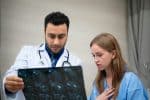Welcome! We’re sure you’ve heard the buzz about deep learning and its transformative potential in many sectors. Among these sectors, the medical field has been garnering special attention. In this article, we’re going to explore how deep learning can play a significant role in early detection of diseases through medical imaging. We’ll examine the application of deep learning methods in medical image analysis and diagnosis, with a focus on image-based disease classification.
Even if you’re a neophyte, with no background in machine learning, this piece will give you a clear understanding of the topic in a light and easy-to-understand tone.
Also to discover : How Are Reinforcement Learning Models Being Applied in Autonomous Vehicle Training?
What is Deep Learning, and How Does it Apply to Medical Imaging?
To understand the application of deep learning in medical imaging, it’s important to first grasp what deep learning is. Deep learning is a machine learning method that models high-level patterns in data as complex multi-layered networks. In the world of medical imaging, these networks have the potential to spot subtle changes that are often invisible to the human eye.
Deep learning models are excellent at analyzing visual data, which makes them perfect for working with medical images. These models, when trained with a large dataset of medical images, can learn to identify the visual features associated with different diseases, and classify them based on these features. This ability to ‘learn’ and ‘recognize’ visual patterns is what makes deep learning models an invaluable tool in medical imaging.
In the same genre : What Innovations in NLP Models Are Revolutionizing Customer Service Chatbots?
Google’s Medical Imaging Algorithm: A Case Study
To illustrate the power of deep learning in medical imaging, let’s take a look at Google’s medical imaging algorithm. Google, a pioneer in machine learning, used deep learning to develop an algorithm that can detect diabetic retinopathy, a disease that can lead to blindness if not detected early.
The algorithm is a neural network model trained with thousands of retinal images labeled by medical experts. This neural network learned to recognize the features associated with diabetic retinopathy and could then classify new images based on these learned features.
This approach is not limited to eye diseases. Google’s algorithm demonstrates that deep learning models can potentially be trained to detect a wide range of diseases from medical images.
Features and Classification: The Core of Medical Image Analysis
The cornerstone of applying deep learning to medical imaging lies in the model’s ability to identify and learn from visual features. Features can be anything that helps identify a disease, such as tissue abnormalities, shapes, textures, or colors.
Once trained with a dataset of images, a deep learning model can classify new images based on the features it has learned. This classification process is essentially the model making a "diagnosis" based on the visual data it analyzes.
Importantly, deep learning models have the ability to learn more complex features than traditional machine learning methods. This makes them more accurate and efficient in identifying and classifying diseases from medical images.
The Challenge of Data in Medical Imaging
While deep learning models hold great promise, they are not without challenges. One of the key hurdles is the need for large datasets of annotated images for training. These are not always readily available in the medical field due to privacy concerns and the time-consuming task of annotating images.
Moreover, medical images are complex and varied. They come from different sources, in different formats, and can have varying quality. All these factors add to the challenge of working with medical image data.
Despite these challenges, progress is being made. Researchers are developing methods to train models with less data, and the medical community is beginning to understand the value of sharing anonymized data for research purposes.
In conclusion, while the path is not without its bumps, the potential of deep learning models in improving early detection of diseases through medical imaging is undeniable. With ongoing research and technological advancements, deep learning could soon play a crucial role in transforming medical diagnostics.
Transfer Learning: A New Approach to Medical Imaging
An emerging topic within deep learning is transfer learning. Transfer learning is a method where a pre-trained neural network is used as a starting point for a new similar task. For instance, a model that has been trained on general images can be fine-tuned for medical image analysis. The assumption here is that the features learned in the original task are also applicable to the new task, potentially reducing the need for large amounts of annotated data.
In the context of medical imaging, transfer learning can be a game-changer. For example, a convolutional neural network, another type of deep learning algorithm, that has been previously trained on a large dataset of everyday images could be used as a starting point for detecting Alzheimer’s disease in brain scans.
This approach significantly reduces the time needed to train the model and, crucially, the amount of annotated data required. With transfer learning, a model can start identifying relevant features in the medical images more quickly, making this method an exciting area of research in early disease detection.
Despite the promising potential of transfer learning in medical imaging, there are still challenges to overcome. The features in general images and medical images can be quite different, and the transfer of knowledge from one to another is not always straightforward. However, with continued research and development, transfer learning could become a key technique in leveraging deep learning for early disease detection.
Deep Learning and Image Segmentation in Medical Imaging
When it comes to the analysis of medical images, image segmentation plays a crucial role. Image segmentation is the process of dividing an image into multiple parts, usually with the goal of identifying different structures or regions. This is critical in the medical field, where distinguishing between healthy and unhealthy tissue, for instance, can provide valuable information for diagnosing diseases.
Deep learning algorithms are proving to be highly effective for image segmentation in medical imaging. They can learn to segment images into the desired regions based on the training data they receive. This ability makes them a powerful tool for identifying features of interest in medical images, such as tumors in MRIs or lesions in CT scans.
The use of deep learning for image segmentation in medical imaging has the potential to increase efficiency and accuracy in disease diagnosis. With more precise segmentations, clinicians can identify abnormalities more accurately, leading to earlier intervention and potentially better patient outcomes.
However, it’s worth noting that while deep learning models may provide impressive results in image segmentation, they must be validated thoroughly before they can be relied upon in a clinical setting.
Wrapping Up
In conclusion, deep learning offers immense potential in the realm of medical imaging for early disease detection. From Google’s pioneering algorithm for diabetic retinopathy detection, the emergence of transfer learning, to the use of deep learning for image segmentation, the landscape is evolving rapidly.
However, this promising field is not devoid of challenges. The need for vast amounts of annotated data, the complexity, and variety of medical images, and the rigorous validation required for clinical application are just some of the hurdles that need to be navigated.
Despite these challenges, the potential benefits of early disease detection through medical imaging using deep learning are immense. As research progresses and technology advances, it’s not too far-fetched to envision a future where deep learning models are an integral part of medical diagnostics, aiding clinicians in making faster, more accurate diagnoses, and ultimately improving patient outcomes.











